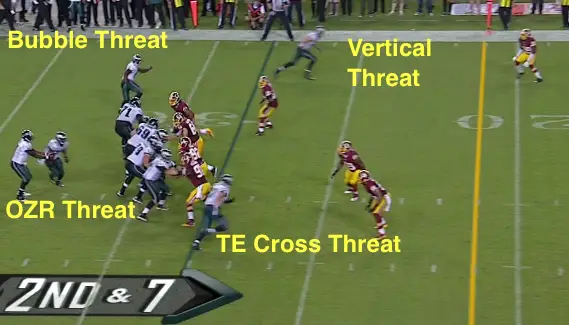“It’s going to be interesting to see if this style of offense projects to the NFL. I’m going to say no. I just don’t see NFL passing concepts in this offense.” – Ron Jaworski
“There’s just so many holes to this offense when you transfer it from college to the pros.” – Heath Evans
Despite bold predictions to the contrary, the Chip Kelly passing game actually did succeed at the professional level in 2013. The Eagles set franchise records for points, net yards and touchdowns as second-year quarterback Nick Foles had the best passing season in the team’s history. When the season ended, records for passing touchdowns, completion percentage, quarterback rating and passing yards had all been broken and the “college passing game,” which many experts called too simplistic to work in the NFL, generated a stat line for the ages.
Critics have countered the Eagles success through the air by claiming Kelly made “drastic changes” to his Oregon passing game. The film tells a different story. Kelly utilized many of the same formations and schemes he used during his stints at both Oregon and New Hampshire. The simplicity some saw as a handicap functioned as an advantage because great passing teams utilize only a small number of base concepts. This allows their players to understand exactly when and where they need to be on the field. Playing fast is not just something Kelly preaches before the ball is snapped. It’s also about understanding and executing the offense once the play begins.
This article will compare two plays — one from the 2013 Fiesta Bowl and one from the Eagles 2013 Monday Night Football opener — and analyze the similarities (in both scheme and success) between the two. (FishDuck note: Frequently in the past I’ve rewritten Coach Flinn’s analyses slightly to make the verbiage easier to understand. This time I am preserving it and adding notes of clarification for those of us who are not coaches.)
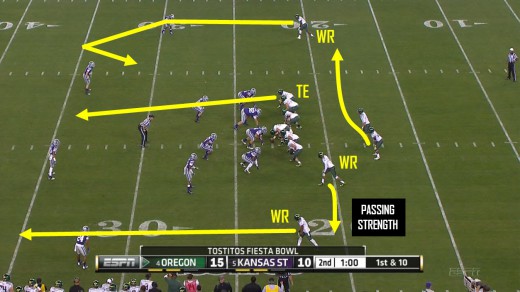
The infamous “Cross” concept.
In the Fiesta Bowl, Oregon lines up in a 2×2 formation with their passing strength set into the boundary (the boundary is short side of the field), as Chip Kelly often deploys his receivers and tight end this way. By lining up two wide receivers into the boundary (and setting the tight end/single receiver running strength to the field or wide side), Chip is trying to widen the boundary safety to create space in the middle of the field. (Make the safety on the short side move over to help cover the two pass receivers on that short side.)
Kelly’s play call — the “Cross” concept I have written about previously for FishDuck, is one designed to attack the middle of Kansas State’s defense. The quarterback, running back and slot receiver sell/show Outside Zone Read packaged with a Bubble Screen to the defense. This run action puts the inside linebackers in conflict between playing run and pass.
While the run action freezes the underneath coverage, the widest receiver into the boundary is responsible for taking the top off of the defense with a vertical route. (WR at bottom of picture is pulling the safety deep and out of the play) The tight end — lined up to the field — will run a crossing route from the field to the boundary. This route attacks the middle of the field and uses the run action to climb over (get past) the linebackers. The wide receiver to the field will run a post curl as an option for the quarterback if the internal coverage chases the crossing tight end.

Run action sucks in the LBs.
When the ball is snapped, the run action by the Oregon offense –(low helmets from the offensive line, outside zone action from the running back and quarterback, Bubble Screen from the slot) — does its job. The inside linebackers react downhill toward the line of scrimmage. The alley defender into the boundary (the defender covering the slot receiver on the short side) is forced to widen with the Bubble Screen.
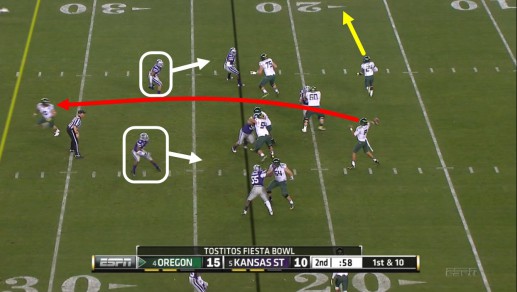
LBs must stop the run first, hence the coverage opening
In the moment before Marcus Mariota delivers the ball, you can see the reaction the Outside Zone Read action gets from the inside linebackers. The linebackers are responsible for pass coverage in the area of the field where Colt Lyerla is heading. However, the run action has forced the linebackers to vacate their coverage zones instead for their first priority of run support and give the tight end a free run to the middle of the field.

Run Support priorities freezes the KSU LBs.
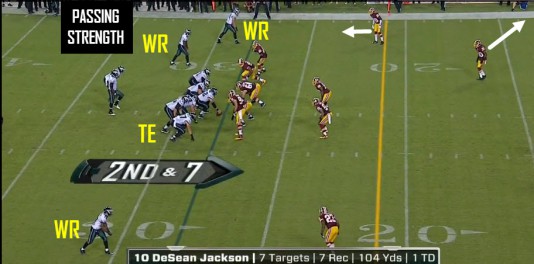
This looks familiar to Oregon fans …
It would have been easy to explain a strong sense of déjà vu for Oregon fans, in the Eagles’ 2013 season opener. In the second quarter the Eagles lined up in the same formation and personnel grouping we saw earlier in this article from the Ducks. The Redskins respond to the boundary passing strength with a two high-safety-look similar to the one Kansas State lined up in.
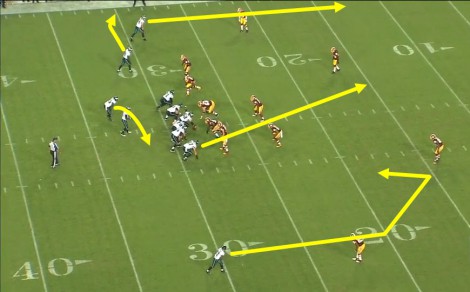
A ton to cover for an NFL defense, as well.
The Cross concept run here by the Eagles, is identical to the one Oregon ran in the Fiesta Bowl, and while this scheme may appear “simple,” it still presents an NFL defense with a lot to diagnose. Combining the Cross concept with the OZR run and Bubble action forces the Redskins to defend the width and depth of the field. The defense also has to figure out quickly if this play is a run, a packaged run/quick screen or a deep play action pass.

NFL LBs have run priority first, as well …
The Redskins defense reacts to this scheme the same way the college defense did. When the ball is snapped, the inside linebackers move downhill with the run fake and the alley defender widens toward the sideline with the Bubble threat.

Run defense opens up the passing lanes.
This end zone view shows why this scheme is effective at any level. The success of the Eagles’ rushing offense earlier in this game has the attention of the Redskin inside linebackers Perry Riley (56) and London Fletcher (59). Much like the Kansas State linebackers before them, the professionals are frozen by the threat of LeSean McCoy and the Outside Zone Read, and this reaction leaves them out of position to defend the pass and unable to slow down the tight end.
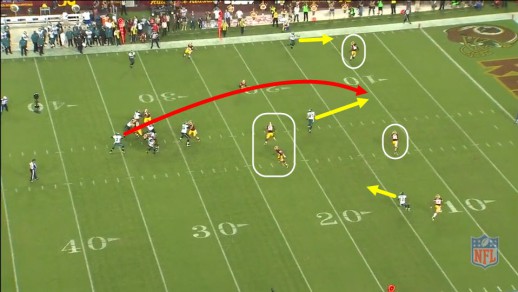
The route helps to open space for the Tight End — Touchdown, Eagles!
The wide angle of this play show the importance of the boundary outside receiver’s route because the vertical route by Riley Cooper has moved the Redskins free safety almost to the sideline. By moving the boundary safety this far off the hash, the vertical route creates space and a touchdown for the Eagle tight end!

Attacking the defense in multiple ways works at all levels.
“Simple can be harder than complex. You have to work hard to get your thinking clean to make it simple. But it’s worth it in the end because once you get there, you can move mountains.” — Steve Jobs
While intended as an insult, there is no better compliment to an offense than calling it “simple.” Our goal as offensive coaches is to find a small group of plays we run well … and then run them over and over. Chip Kelly’s scheme appears simple (due in large part to the hard work he’s done designing it) but it forces a defense to cover the entire field. It is a scheme that combines run with pass and tempo with old fashioned physical football. Kelly has succeeded because this offense is built on what his players do well, as his system then puts them in position to both learn and succeed. If that’s what a “simple” offense is made of, none of us should ever want to be complex.
I may be in Pennsylvania, but “oh how we love to learn about your Beloved Ducks … and our Eagles!”
Brian Flinn
Receivers Coach
Villanova University
Twitter: @Coach_Flinn
Coach Brian Flinn (Football Analyst) is entering his seventh year as Villanova University’s Wide Receivers Coach and Recruiting Coordinator. A native of Youngstown, OH, Brian Flinn was an All-OAC tight end at Mount Union College before entering the coaching ranks. In addition to Villanova, Coach Flinn has coached at Eastern Illinois University, Drake University, Maryland University, and Mount Union.
Go Villanova Wildcats!

